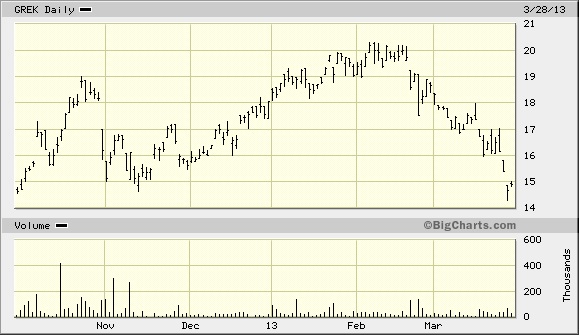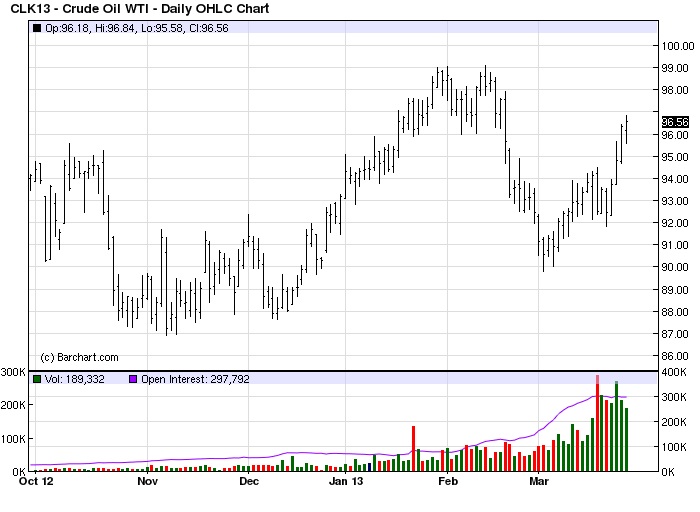Will Europe Eventually Sink Stocks and Boost Gold?
Wall Street expressed relieved that Europe’s central bank agreed to release 10 billion euros ($13 billion) of emergency rescue funds for Cyprus. In exchange, Cyprus agreed to shrink its banking industry, cut its budget, implement economic reforms and privatize some state assets. Although the measures are expected to result in heavy losses for Cyprus’ bondholders and large depositors, Wall Street was just glad to dodge another bullet.
Optimism over the lack of panic in Cyprus pushed the S&P 500 (SPX) to a record closing high. The new high in the SPX was preceded two days earlier by a new high in the NYSE Advance-Decline (A-D) line, a sure sign that higher prices were ahead. Internal momentum on the NYSE is also still rising, which helps dictate the path of least resistance for stocks in the near term.
The big question on investors’ minds is how much longer the U.S. stock market can continue to avoid Europe’s increasing troubles? It has been 130 days since the market has seen a pullback of at least 5-10%. Many investors wonder if we’ll ever see such a pullback again as long as the Federal Reserve has the proverbial “pedal to the metal” with its loose money program. The answer to this question is more than likely “yes” considering that the market has always had such corrections in previous quantitative easing (QE) periods.
Witness the declines in the stock markets of several major European nations as well the continued weakness in the euro currency. European bourses were considerably weaker for the week, led by a fresh new quarterly low in the euro ETF (FXE). Spain’s IBEX 35 stock index was down by as much as 6%, testing its quarterly low while the Italy ETF (EWI) dropped 5% in a 2-day period.. The country that got the euro zone avalanche started back in 2010 – Greece – saw its stock market decline to yet another new low today via the Greek ETF (GREK) shown below.

As Sharps Pixley pointed out, “Although the Finance Ministers highlighted that Cyprus is a special situation, the European banking crises and contagious effects are very real.” Italy meanwhile still doesn’t have a government. Each of the stock markets and country ETFs mentioned above present a picture of a weakened continent vulnerable to even the slightest bad news.
Speaking of financial contagions, Randall Forsyth, writing in this week’s Barron’s, pointed out the history of overseas financial crises and how they all have a history of eventually making their way to the U.S. Sixteen years ago the Thai baht became the first major currency to fall in the Asian currency crisis. That crisis eventually spread beyond the region and made its presence felt in the U.S. and around the world. The collapse of Long Term Capital Management hedge fund in 1998 and near meltdown of the global financial system was a result of that contagion.
“In 2008,” wrote Forsyth, “Iceland was the improbable site of a credit bubble and bust. Money flooded into the island nation’s burgeoning banks in pursuit of high returns. Eventually, the amount at issue grew to about 10 times the size of Iceland’s economy. But the bubble’s collapse led to defaults to foreign creditors, notably those in the U.K. and the Netherlands, and a massive devaluation of Iceland’s currency, the krona.”
Then there was the crisis with Greek government bonds in 2010 which required a massive bailout. The crisis in Greece spread to banks in Ireland, Spain, and Portugal, with spillover effects on U.S. equities.
The fear among investors is that Cyprus’ move to essentially penalize large bank depositors will feed a larger fear that this will become the norm in troubled European nations. Rana Foroohar pointed out in the latest issue of Time that the current Cypriot government was voted in because it promised to protect bank deposits. “Even if small depositors end up safe,” she wrote, “even if Cyprus doesn’t become the economic equivalent of the assassination of Austrian Archduke Ferdinand, which started World War I – the damage to trust has been done.” As Mohamed El-Erian, CEO of PIMCO, pointed out, “The population is quickly losing confidence in the political order.”
All of which is to say that the fatal concoction of European bank troubles and a weakening euro currency along with depositor/investor mistrust of banks could easily result in another financial contagion in the coming months. And this is just the sort of thing the gold market could use to reverse its fortune.
Price of Oil
Is the Fed’s QE program increasing food and fuel costs for consumers? Peter Kenny, managing director at Knight Capital Group, thinks so. In an interview with Breakout.com he stated that the Fed’s QE policy is pushing up the price of fuel, which in turn raises the price for everything else in the economy. While monthly headline inflation data is below the Fed's 2% target, Kenny and many other market watchers see it showing up elsewhere “in everything we assume is a part of our daily life.”
According to Kenny, QE is pushing up the price by about 50% instead of the $65 a barrel level where he believes it should be based on current supply and demand. Since the Fed is actively injecting more money into the economy, he says that has resulted in “more dollars chasing that fuel” leading to higher prices.

Kenny also sees evidence of the Fed’s intervention in the stock market. “The soft bid we see in equity markets and that we run into every time there’s a sell-off, that soft bid is the direct result of quantitative easing.”
Few investors doubt the effects of the Fed’s stimulus efforts in boosting oil and stock prices. Without the impact of higher oil prices the effects of the deflationary long-term cycle would be evident in every sector of the economy. What’s debatable is how it all ends. Will the Fed succeed in beating the 120-year deflationary cycle scheduled to end in 2014 with its QE policy? Or will the structural forces of deflation prevail despite the Fed’s strongest efforts as we head closer to the final bottom of the cycle?
Mr. Kress himself always believed that while stimulus could temporarily soften the blow of the cycle, no amount of central bank/government intervention could ultimately stop the Master Cycle of inflation/deflation. It’s too early to say with any certainty that Kress was wrong but we’ll at least have a better idea just how power the Fed has over the market once we see the market’s reaction to the upcoming quarterly cycle peak.
Consumer Spending
Dr. Scott Brown of Raymond James Financial last week wrote a prescient commentary on U.S. consumer spending worth mentioning. “One often talks about ‘the consumer,’” he wrote, “but there’s no such thing.” Brown pointed out that the top 20% of income earners account for about half of personal income and half of consumer spending. Spending for the top 20% of households likely won’t be much affected much by the payroll tax increase, delayed tax refunds, or higher gasoline prices. Stock market wealth gains will also increase spending for the upper 20% group, he added.
“Note that the stock market wealth effect on spending is relatively small, but a large enough change in wealth can certainly move the needle on spending. The wealth effect is also asymmetric. A 20% rise in stock market wealth may add about 0.6% to spending, while a 20% decline might reduce spending by about 2.0%.”
Dr. Brown went on to say, “For the other 80%, the payroll tax increase and higher gasoline prices matter a lot. Recall that, for a household making $60,000 per year, the payroll tax increase reduced spending by $100 per month. The payroll tax reduction of the last few years was perhaps the most unadvertised tax cut in history. Most people were unaware that the cut had occurred, but the added take-home pay helped support consumer spending growth.”
He concluded: “Many workers were unaware that the payroll tax rose in January. Hence, the impact on consumer spending is likely to show up with a lag. In addition, higher gasoline prices normally have a lagged effect on spending. Gasoline prices may be falling now, but the full impact of the rise in February has yet to be felt.”
Momentum Strategies Report
The stock market recovery is nearly four years old, and investors wonder if it will continue. While many experts have made forecasts for the coming year, few have been as impressive as the Kress cycles in projecting the market’s year-ahead performance since the recovery began.
Each year I publish a forecast for the coming year based on a series of historical rhythms known within Kress cycle theory. Last year’s forecast was remarkably accurate in predicting the pivotal market turns, including the June 1 bottom in the S&P.
Here’s a sampling from last year’s forecast:
“The first five months of 2012 will likely be characterized by greater than average volatility....This will create a level of choppiness to coincide, if not exacerbate, the market’s underlying predisposition to volatility owing to the euro zone debt crisis…the May-June 2006 stock market slide could be repeated in May-June 2012. Our short-term trading discipline should allow us to navigate this volatility and there should be at least two worthwhile trading opportunities between [January] and the scheduled major weekly cycle around the start of June 2012. From there, the stock market should experience what amounts to the final bull market leg of the current 120-year cycle, which is scheduled to bottom in October 2014.
“Keeping in mind that like snowflakes, no two markets are exactly alike, the Kress cycle echo analysis for 2012 tells us to expect a final upswing for stocks in the second half of the year with the first half of 2012 likely to be more favorably to the bears, especially if events in Europe are allowed to get out of hand.”
This is your opportunity to find out what the Kress cycles are telling us to expect for 2013. Subscribe to the Momentum Strategies Report now and receive as my compliments to you the 2013 Forecast issue.
In addition to that you’ll also receive the MSR newsletter emailed to you each Monday, Wednesday and Friday. MSR provides reliable forecasts and analysis of U.S. and global markets based on internal momentum, cyclical and technical factors. Low-risk stock and ETF recommendations are also made based on my proprietary system of selection. Specific entry and exit instructions are also given for each recommendation.
[For the complete 2013 Kress cycle forecast for the U.S. stock market and the latest newsletters, subscribe to the Momentum Strategies Report at the link below.]
http://www.clifdroke.com/subscribe_msr.mgi
Clif Droke is the editor of the three times weekly Momentum Strategies Report newsletter, published since 1997, which covers U.S. equity markets and various stock sectors, natural resources, money supply and bank credit trends, the dollar and the U.S. economy. The forecasts are made using a unique proprietary blend of analytical methods involving cycles, internal momentum and moving average systems, as well as investor sentiment. He is also the author of numerous books, including most recently “2014: America’s Date With Destiny.” For more information visit www.clifdroke.com
















